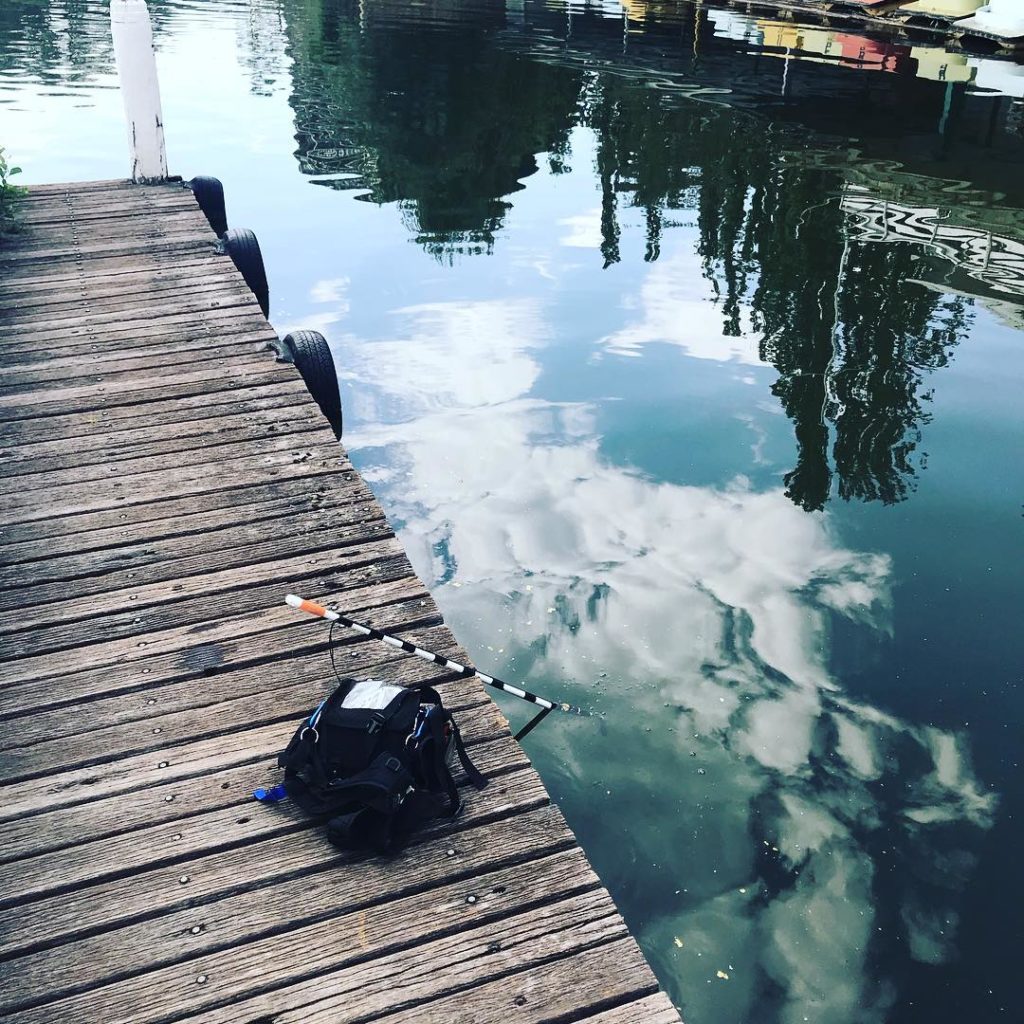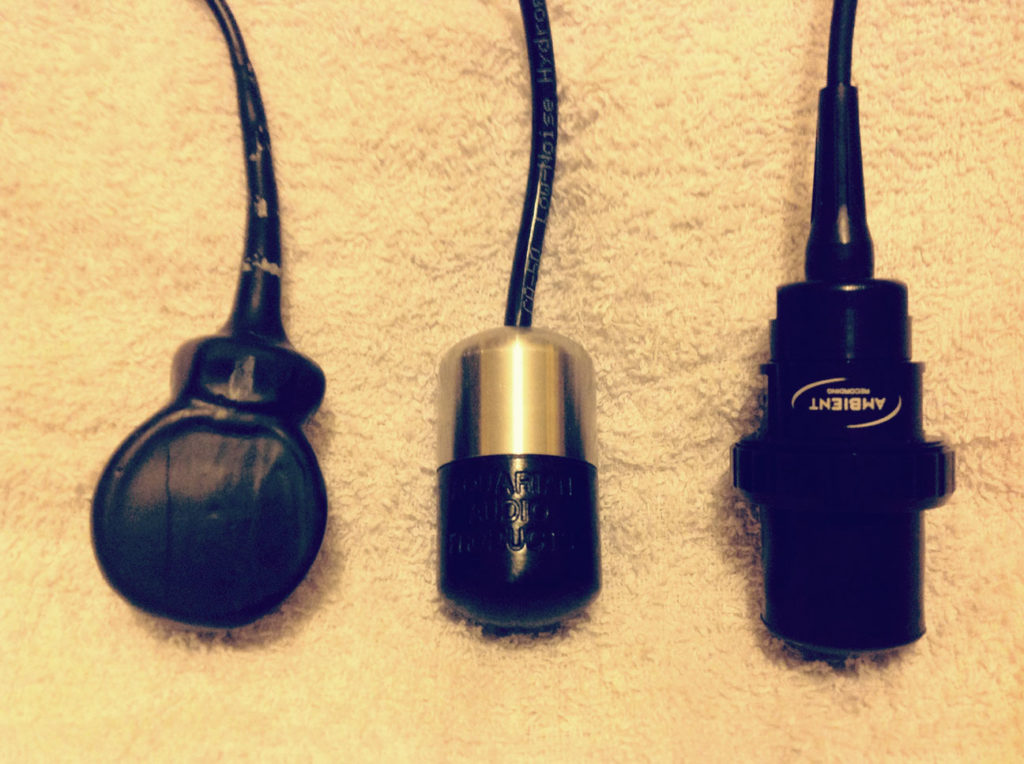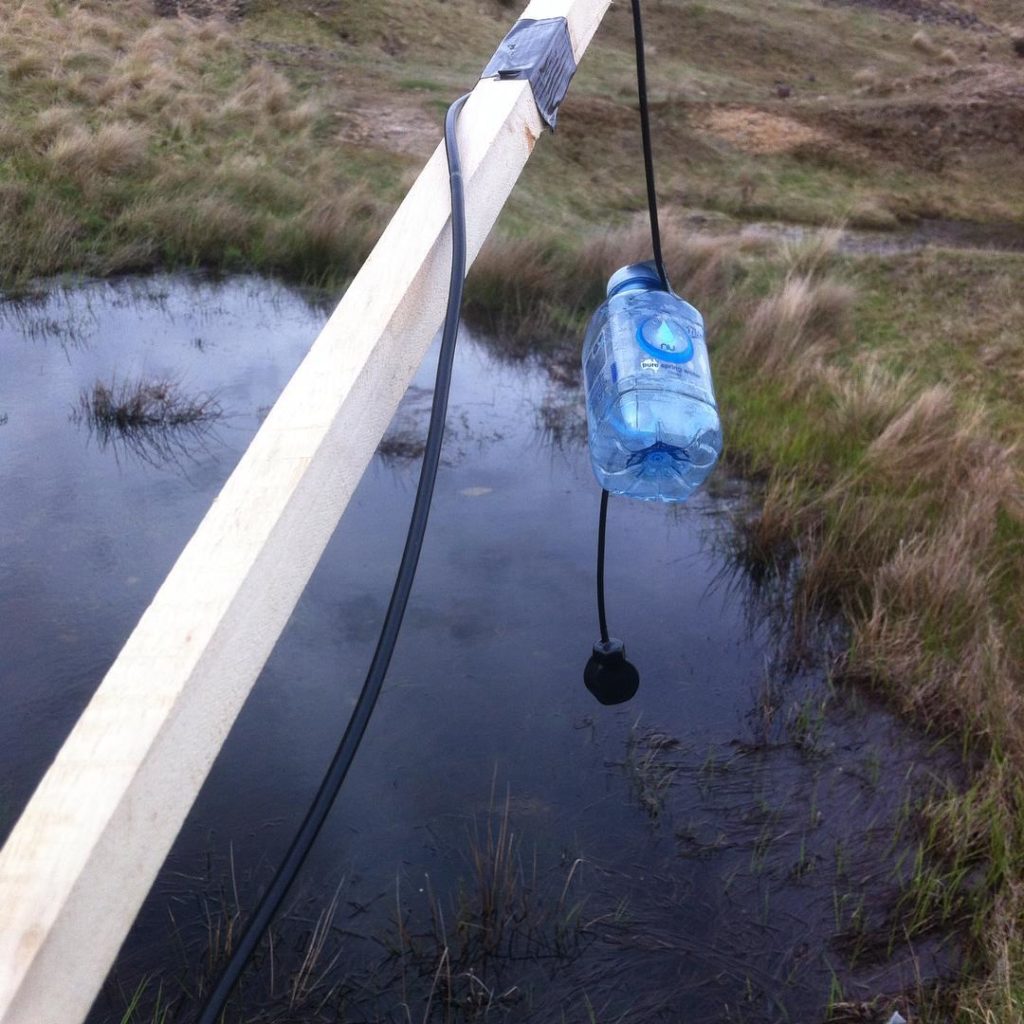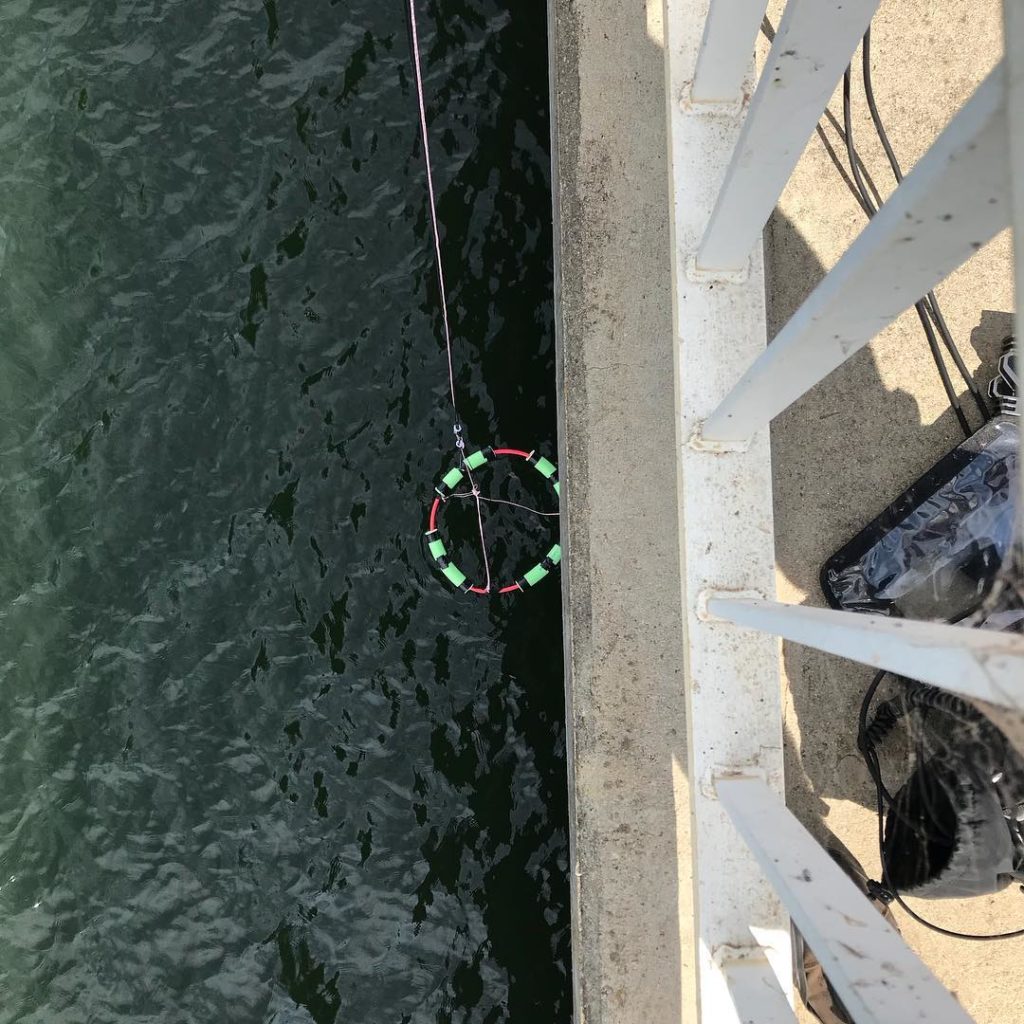I have been making some field recordings using hydrophones (underwater microphones) for a number of years now, mostly for general field recording, but also for Foley for some TV and film projects. I’ve had the opportunity to test out a couple of affordable options over the past couple of years. In no way do I consider myself an expert when it comes to recording underwater, but I thought it might be useful to share some of the things I have learnt about it in this blog post.

Sound Underwater
Humans are not used to listening to sound underwater, so first of all it is good to get a basic understanding of the differences between how sound behaves in air versus water.
I have attempted to keep things fairly simplified below. Acoustics can get quite complicated at the best of times, let alone when we are dealing with mediums other than air. I personally find it difficult to wrap my head around and describe some aspects due to the frequency dependent nature of sounds behaviour, which makes it feel like a simple statement doesn’t do justice to the whole picture at different frequencies. Regardless, here we go…
Water has a larger acoustic impedance than air
Due to the physical differences between air and water, not much sound that is in the water travels out of the water into the air. Only approximately 1% of the sound from underwater travels out into the air, so there is often sound activity under the water that we can’t hear even if we are standing right next to the water’s edge.
Sound travels much faster in water than in the air
Sound in water travels at approximately 4.5 to 5 times the speed it does in air, although the exact speed depends on other factors such as temperature. The higher the speed of sound and therefore the longer the wavelength.
Speed of sound in air = approx. 343m/s at 20 degrees Celsius
Speed of sound in water = approx. 1450-1500m/s (more like 1530m/s in the ocean)
This makes the wavelengths of sound waves in water much longer so that makes for a very different acoustic environment to what we are used to.
This and many other factors such as the sensitivity of hydrophones to movement and handling noise make underwater audio recording quite a challenge for field recordists if they want to obtain engaging and immersive recordings.
Water absorbs/attenuates less sound than air
Sound travelling through the air will be attenuated over distance by absorption, but attenuates less over distance in water. As an aside, there is generally less attenuation in air of higher humidity then in air of lower humidity.
A lot of people have heard that sound can travel huge distances in the ocean, and this is primarily in reference to the SOFAR channel, where pressure gradients create an excellent medium for sound propagation at a depth of between 750 and 1,000 metres below the surface of the ocean. I can’t say I’ve had the pleasure of recording anything in the SOFAR channel (obviously it takes some technology to make that possible), but in case you want to learn more about that, there is a good explanation of the SOFAR channel at https://dosits.org/science/movement/sofar-channel/sound-travel-in-the-sofar-channel/
Because sound can travel long distances under water it can make it difficult to escape unwanted noise in recordings in some locations.
Decibels are measured differently in water than air
I remember being told how loud some creatures in the ocean can get in decibels, and at first thinking it couldn’t be true, but then later learning that decibels are measured with a different reference in water than in air, so it is not a straight comparison.
0 dB SPL in air is 20 µPa, which corresponds to the threshold of hearing, but the reference level for sound in water is 1 µPa. The following explanation can be found at http://www.sengpielaudio.com/calculator-airpressure.htm:
| In 1970, the pressure reference level of 0 dB ? 1 µPa was chosen by the US Navy for their underwater work for sound in water. Approximately the same level of detail for air and water at their respective reference pressure in level differ by approximately 62 dB. So withdraw from the sound level of water about 62 dB to compare with sound level of air. |
The Sengpiel Audio website has plenty of other amazing acoustic information too if you are hungry for more technical acoustics information.
The Hydrophones
I have experience with a a few of the more affordable hydrophones available to sound recordists so I will share what I found out about them below.
The three hydrophones I will focus on are:
- JrF Hydrophone, which are quite affordable and are hand made by Jez Riley French in Britain. I have a few of these.
- Aquarian Audio H2a-XLR, which is a rugged option with an XLR connection and a built in phantom-powered preamp.
- Ambient ASF-2, which is another rugged option with an XLR connection and a built in phantom-powered preamp.

Costs
Prices might be a bit variable due to currency fluctuations, but the JrF is the cheapest in its raw form (although you would ideally allow for a preamp such as Triton Audio BigAmp Piezo or transformer such as Hosa MIT-129 with it), with the Aquarian Audio H2a about 2-3 times the price, and then the Ambient ASF-2 about 2-3 times the price again.
Please note that you can go DIY for a cheaper option, or there are also higher end hydrophones available from Ambient (ASF-1), or the discontinued DPA 8011 or some hydrophones that are designed more for scientific research rather than audio recording too, but these tend to be a lot more expensive, coming in at many thousands of dollars generally, or tens of thousands dollars potentially if you want to set up a comprehensive multi-channel recording rig.
Polar Response
A few years ago when I first tested the H2a-XLR out against a JrF recording in a local lake. The lake is quite shallow (around 50cm before a muddy bottom from the edge where I was), and I dropped both hydrophones in a short distance (20-30cm). On the JrF I was getting some nice clear close chirps of waterboatmen insects in the water, but on the H2a-XLR I was getting much less of that sound. At first I thought it must have been a sensitivity thing so I turned up the preamp gain on the H2a-XLR, but then after I played around with positioning I realised that the H2a-XLR was actually quite sensitive in the direction of the muddy bottom, but much less so to the sides when it was hung by its cable in the usual configuration. When I pointed the H2a-XLR to the side (across the lake) I got much more of the chirps of waterboatmen insects.
The standard way of measuring the polar response of hydrophones seems to be in the horizontal field only. I’m not totally sure of all the reasons, but this can be a weird thing for sound people who who are used to reading regular polar responses and thinking in 3D, whereas the hydrophone specs might be 2D in a horizontal plane.
I asked Jez Riley French about the polar response of his hydrophones and he suggested something like a wide cardioid, and I have found this to be true in my experience in the field. The wide (almost true spherical omni) response suits the sort of field recording that I do.
The Aquarian Audio H2a-XLR and Ambient ASF-2 are both listed as omnidirectional in the horizontal plane, but it is worth noting that I have found both of those to be more directional than the JrF hydrophones. I did some very limited testing if a container of water at first and then in a swimming pool, and I found the Aquarian Audio H2a-XLR to be quite directional, and the Ambient ASF-2 to be directional but less so. So if trying out hydrophones please try them out pointing in different directions to see what works for your situation.
Frequency Response and Sensitivity
More affordable hydrophones tend to be built around piezo discs, and these have a limited frequency response and a very real resonance to them which can limit the fidelity of them. Think a DI recording of acoustic guitar rather than a nice condenser microphone recording. Hydrophones based on piezo discs tend to have a limited frequency response and quacky resonant mid-range.
The stated “useful range” of the Aquarian Audio H2a-XLR is <10 Hz to >100KHz, but the sensitivity is noted at +/- 4dB 20Hz-4.5KHz, which gives a better idea of the flat(ish) frequency response range.
The JrF doesn’t have a published frequency response specification (as far as I can tell), and the frequency response will be quite influenced by the impedance of whatever you are plugging it into. From my experience I would suggest that the JrF has a similar frequency response to the H2a-XLR when paired with a Triton Audio BigAmp Piezo preamp, and it has a little less low frequency response when paired with a Hosa MIT-129. If you want to read more about my thoughts on the BigAmp Piezo or MIT-129 then check out this blog post.
The Ambient ASF-2 states “Linear Frequency Range” of 70Hz-20kHz, and in my testing it certainly seemed to have a much wider and flatter frequency response than the JrF and H2a-XLR, but it has much lower sensitivity and therefore requires a lot more preamp gain in comparison. I am not sure of the design of the ASF-2, but I suspect it might use a PVDF type sensor rather a ceramic piezo disc as I suspect the JrF and H2a-XLR are based on. This goes some way to explaining the differences.
So how much less sensitive is the Ambient ASF-2? To be honest I am not 100% sure, as in my testing I found it to be a lot less sensitive, to the point where I thought that I had a faulty unit. Ambient later advised me that the ASF-2 can undergo thermal shock if it is put into water that is of a much different temperature to the unit, which reduces the sensitivity temporarily by about 40dB and it can take minutes to return depending on the temperature difference. Unfortunately the low sensitivity of the ASF-2 made it not very useful to me for what I do so I sent it back. Apparently the Ambient ASF-1 has much higher sensitivity, wider frequency response and doesn’t suffer from the thermal shock thing, so by all accounts it would seem like a good option, but it also costs around ten times as much as an Aquarian Audio H2a-XLR which made it too pricy for me, especially when I’d want a pair of them.
Stereo Recording
I have read in a spot or two that it is impractical to make stereo hydrophone recordings due to the spacing needed between the hydrophones because of the longer wavelengths of sound in water, but in my experience this is not completely true, but your approach and the stereo effectiveness does depend what you are attempting to record.
The first time I put a pair of JrF hydrophones in a small dam at my place some years ago I was greeted by the sounds of lots of insects with a good stereo spread. From memory the hydrophones would have been between 20 and 40cm apart. Check out the first recording at:
http://versed.com.au/projects/hydrophonerecordings
It will come as no surprise to sound recordists that there are a number of factors that might influence the success of a stereo recording. Spacing is key of course, and yes it makes sense that we would need to change our spacings in the water compared to microphone spacing in air – in theory we should multiply spacing in air by about 4 or 5 times to get the equivalent spacing in water in terms of time and phase differences. The polar and frequency response of hydrophones are also big factors in considering how they might be utilised for stereo recording. Lastly, how close the sound source is to the hydrophones has a huge effect on the stereo effect due to the intensity differences.
I’m not going to attempt any scientific explanation of the acoustics involved with stereo hydrophone recording, but I will share a soundscape comprised primarily of stereo hydrophone recordings and discuss the stereoness (is that even a word?) of the piece. Listen to some or all of this:
All of the recordings that make up this soundscape were recorded in stereo with a pair of JrF hydrophones, except for one which is an electric boat passby late in the first minute, which is a mono recording panned in the stereo field. I did that primarily because of an equipment issue I had with one channel in that recording, although because I was using almost omnidirectional hydrophones at a fairly close spacing of 30-40cm recording a somewhat distant sound from the boat (20-30m away at the closest) it didn’t have the stereo passby effect I was after in this case.
There was no other panning on recordings, and the hydrophone spacing for most other recordings ranged between 30-40cm for a lot of it, getting a bit wider to closer to 1m apart for some, and then even wider for a few moments. From around 7:38 you start to hear a kayaker (me) kayaking past the mics, and for this you can hear a wider configuration with the hydrophones spaced a few metres apart. Again, no panning on this, just 2 channel stereo recording.
Mounting
Hydrophones are generally designed to be simply dropped into a body of water hanging by their cables. This can work well if recording from a boat or a jetty, but it may not be flexible enough for more precise placement.
I vary up my hydrophone placement with a few set-ups. Sometimes I will use a float of some sort, usually based on a pool noodle loop on a painters pole. I have also mounted hydrophones on boom poles and other sticks and poles.
Ambient have some accessories for their more expensive ASF-1 which includes a Directivity Sphere to convert the omni hydrophone into more of a supercardioid polar response and an underwater stereo bar which looks quite cool (but I imagine it is not cheap).
One thing to note is that most hydrophones are very sensitive to handling and cable-borne noise, which can really add to the challenge of getting good hydrophone recordings.
I believe there is scope for better mounts for more specific placement of hydrophones for field recording, but at the lower budget end of town things are generally quite DIY on this front. Check out a couple of photos or recording rigs below for examples.


Summary
With over 70% of the Earth’s surface is covered in water, it seems like there is plenty of room for people to have a crack at recording underwater. Field recordist Chris Watson has been quoted as suggesting that we should be calling it “Planet Ocean” rather than “Planet Earth”.
At different times in the past I have contacted Jez Riley French, Aquarian Audio and Ambient to ask questions about hydrophones, and I am pleased to report that they have all been quick to respond and happy to answer questions. I love that we’re in an industry that is full of people passionate about their work and happy to help others.
All of the hydrophones I have used have pros and cons. I primarily use the JrF hydrophones with Triton Audio BigAmp Piezos and have been reasonably happy with this set-up for the price. The wide polar response works well for the general field recording that I do. The Aquarian Audio H2a-XLR is a really rugged unit that eliminates the need for additional preamps or transformers at a reasonable price, and some people also like to use them as contact mics. The Ambient ASF-2 offers a flatter, wider frequency response but with the trade-off of much lower sensitivity and higher cost.
I’m very interested in testing out some other hydrophones in the future. Aquarian also have Aquarian Scientific branded hydrophones with more focus on wider frequency responses and fidelity, but at higher cost and lower sensitivity. The Ambient ASF-1 sounds great on paper, and in the demos I have heard online, but I haven’t tried it yet for fear that I’ll really like it and then have to rustle up many thousands of dollars for a stereo rig comprised of those. There are other brands out there too.
If you have any feedback about this post or hydrophone recording experiences that you would like to share then please get leave a comment/reply below or get in touch.

https://soundcloud.com/tsjmusic/humpback-whales
This is a recording of whales I made in Hawaii. I used a Tascam DR-05 stereo recorder which I put in a Aquapac bag which I then sunk about 15 feet below the surface while snorkeling off the beach in Maui in the winter. Couldn’t monitor the recording but I could hear them while swimming. I was pleased.
Thanks for this very good article that introducts us to this world !
Possibly the best article on the subject I have read. The Aquarian does seem the best compromise in most opinions.
Gracias y que lo disfrutes
Thanks a lot for this article!
Did you find a nice DIY solution to keep the H2a pointing where you wanted them to point at?
I’m actually recording motors of outboards boats and voices underwater with the Aquarian Audio and i agree with your directivity sensations.
I’m trying to construct a convenient stereo-set for my H2a right now…
Thanks!
Yes as the H2a is quite rugged and a similar diameter to a lot of dynamic microphones for stage sound we have often used a microphone clip for a Shure SM57 or similar to hold the H2a in position on a microphone stand.
Hello your article is very interesting, I will buy the audio triton but I do not know which to choose between the fethead and the fethead phantom for the JRF hydrophone. Can you advise me please?
I forgot to specify that I have a MIT-129 to connect my JRF hydrophone to my zoom f4, can I have a fethead audio triton or a phantom fethead?
Hi Benoit, if connecting your JrF hydrophone to a mic preamp with XLR and phantom power then using a Triton Audio BigAmp Piezo is a good match up for impedance. If you want to use your Hosa MIT-129 but just want more clean gain then using a Triton Audio Fethead should work for you. You don’t need the Phantom version as the MIT-129 is a passive device and doesn’t require any phantom power.
Thanks to your brilliant write-up I am going to replace my MIT-129s with Triton Audio BigAmp Piezo (especially for gain clarity). Am I correct in thinking, that through using a Sound Devices MixPre-3 with phantom power on, the Triton Audio BigAmp doesn’t need to have phantom? Or in your experience is it best to turn the phantom off on your recorder and let the Triton Audio BigAmp do the work?
Thanks Connor. You will need phantom power turned on on your Sound Devices MixPre-3 to power the Triton Audio BigAmp. The Triton Audio BigAmp requires phantom power to be sent to it to operate.
Thank you for interesting article. I have been doing some experiments with a hydrophone that looks similar to the jrf type. I did not get the results I was hoping for until I also bought a high input impedance amplifier, HY-11.
Here is a link to the hydrophone I bought. https://www.h-instruments.com/product/hy-03
Thanks for reading and sharing your experience.
Tim, thank you so much for this thorough and interesting article! I have been using pretty much those same hydrophones for a few years now and you have nailed all the questions/points that arise in the mysterious art of underwater recording 🙂
Thanks Angel!
An excellent article! I enjoy reading your work, well done.
-Al
Thanks Al!
Thank you for the very interesting insight and great read.
I was wondering, when it comes to cable lengths do you have any suggestions? I see that some microphones come from the factory with 3. 9 or 15 meters and although having a longer cable can offer some flexibility, i am worried the extra length might be more sensitive to handling noise.
cheers
Thanks for reading and for your comment/question Greg.
I have mostly used my hydrophones in fairly shallow water, mostly freshwater, and have found cables around 5m to be fine. If you are planning to go out to deep waters then I imagine the longer cables might be an advantage there. The other factor is that if you use a passive piezo based hydrophone such as the JrF ones there is a high impedance and the signal might degrade a bit with longer cable lengths before the preamps or impedance matching devices. In terms of the handling noise, this can be a challenge with any length cable!
Cool, thanks for your insight Tim!